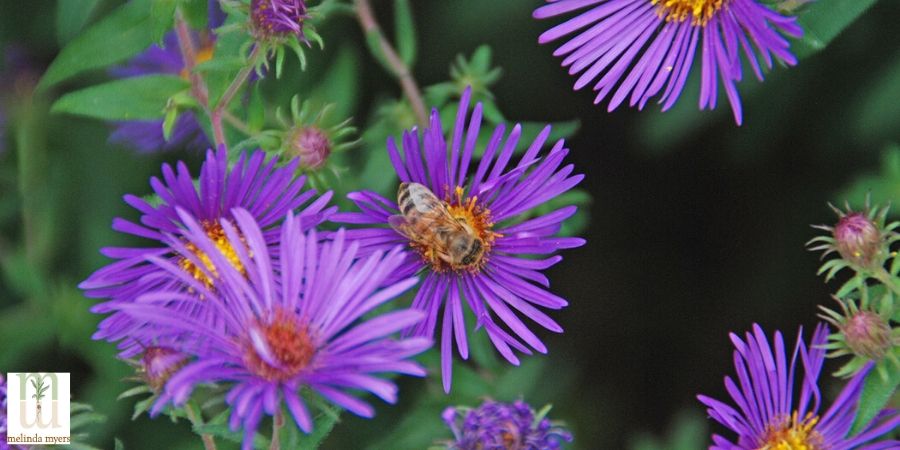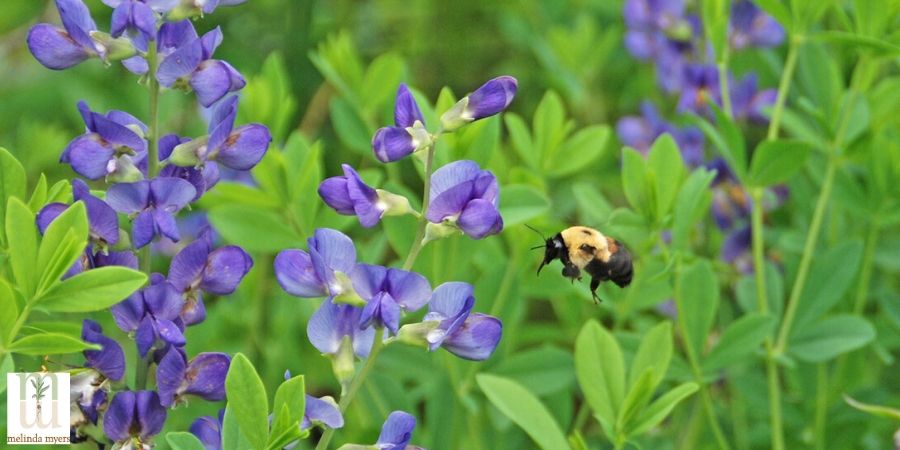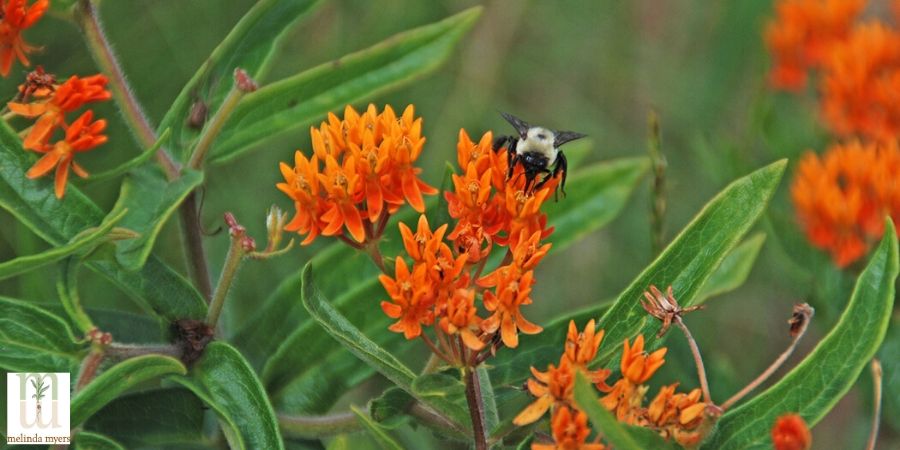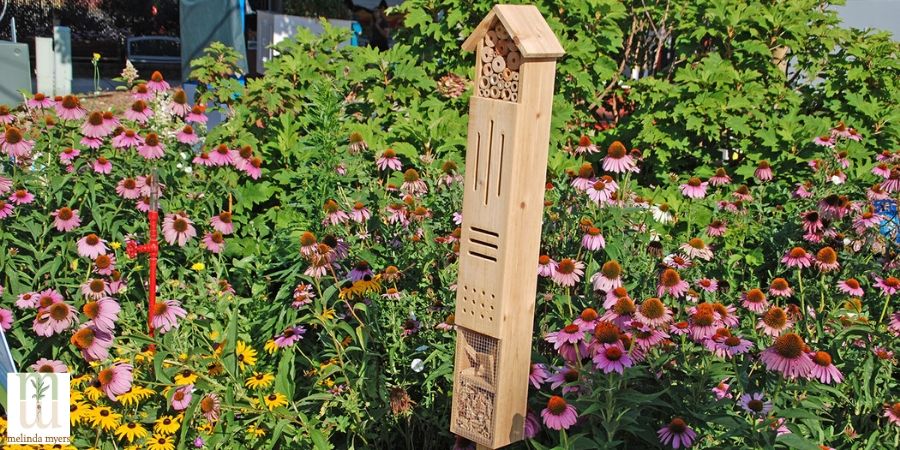Creating a Bee-Friendly Garden
- horticulturist and gardening expertFebruary 8, 2020
Most of us are aware of the plight of the honeybee. Pesticides, diseases, loss of habitat, predators and parasites are a few factors contributing to honeybee’s decline. But our native bees’ populations are also declining. These often-overlooked bees are major pollinators in our gardens and agriculture crops.
Why Garden for Native Bees
Attracting native bees to your garden is more economical than purchasing bees, a beehive, and beekeeping equipment. And native bees need no regular maintenance. Just create the habitat and they will fend for themselves. This habitat and a few changes in your landscape maintenance will attract more native bees and help honeybees and other beneficial insects thrive. This means a more productive garden and a healthier landscape.
Plants that Attract Native Bees and Other Pollinators
Like any living organism, native bees and other pollinators need food, water, and shelter. Plants are their main source of food. Design a landscape filled with a variety of trees, shrubs, and flowers to attract a diverse group of native bees and pollinators. The more diverse the visitors, the better for the health and productivity of your garden.
Include plants with different colors and shaped flowers. Grow lots of purple, blue, white, and yellow flowers that are favored by bees. Plant flowers in mass. You’ll enjoy the display, the garden will require less maintenance and you‘ll get the attention of the bees you are trying to attract. Plus the bees will use less energy when they can gather lots of food from a smaller area.
Make sure you have something in bloom throughout the growing season. Spring bulbs, wildflowers, and perennials provide essential food that is often in limited supply early in the season. Fall flowering plants provide needed energy supplies as the bees and other pollinators prepare for winter.
Bigger flowers are not always better. Double flowers may be showy but they have less nectar and pollen. The multiple layers of petals hinder access to what nectar and pollen they contain.

Aster Flower (above)
Include some smaller flowers for short-tongued bees like the halictid, cellophane, and yellow-faced bees. They can only gather nectar and thus pollinate flowers with shallow nectaries like asters, daisies, and members of the carrot family. Longue tongued bees like bumblebees, as well as miner, leaf-cutter, carpenter and mason bees gather nectar from tubular flowers like salvias, penstemon, and monarda. Honeybees are in between and gather nectar from a variety of flowers. If the nectary is too long they may bore a hole in the side of the flower to reach the nectar inside.
Grow some herbs in the garden and containers for you and the bees. Let some go to flower and watch for visiting bees on thyme, borage, oregano, and other herb flowers.
Grow native plants whenever possible. They are a richer source of nectar and pollen than cultivated plants. Plus the native bees and other beneficial insects have evolved with these plants providing a mutual benefit.
Do some research and ask for help when selecting plants and designing your garden. Contact your local University Extension Service, nearby botanical garden or nature center for help selecting the best bee plants for your region and growing conditions.
Include Water, Mud and a Damp Puddle
Even though nectar contains 80% water, bees and other pollinators need water to dilute food for their young and to stay hydrated. Honeybees also use water to keep the hive cool during the hot summer months.
Birdbaths, fountains, ponds and other water features are attractive landscape features that provide essential water for birds, bees and other insects. Look for water features with sloping sides or set a few rocks in the bottom so the bees can easily reach the water without getting their feet wet.
Keep your water features clean and mosquito-free. Moving water is less prone to algae and prevents mosquito breeding. Change the water in birdbaths every few days. I wash out my birdbaths every time I water my container plants. It makes it easy to remember and do since it is part of my daily routine.
Add a muddy spot for bees like the Mason bee that use it for walling up their nest cells. Just clear away some grass or plants and keep the soil damp. Those with sandy soil may need to add some clay soil to help retain moisture. You can buy mason bee mud kits or create your own muddy spot. I was lucky enough to watch mason bees laying eggs in a nesting box. The female would lay an egg in a hole then leave to retrieve some mud. She would crawl back into the hole to seal off the egg and repeat the process.
Then add a damp puddle somewhere in the garden. Fill a shallow container with sand, keep it damp, and sprinkle with sea salt. You will find butterflies and bees stopping buy for a mineral-rich drink.
Provide Shelter in Your Bee Garden
Select an area away from activities for creating bee nesting sites. Hedgerows, brush piles of sumac and raspberry canes, non-mowed spaces, leaf litter, bare ground, as well as holes in tree branches and trunks can provide nesting sites. Native bees vary on their preferred nesting sites. Providing a variety of habitats, just like flowers, can attract more pollinators to the garden.

Baptisia (above)
Most native bees are solitary. They do not live in colonies with a caste system of Queen bee and workers. Instead, each female lays and tends to her own eggs. Some solitary bees are gregarious and nest near each other.
Social bees like the honeybee live in colonies where groups of adult bees have specific tasks. The queen is usually the only one that lays eggs while the workers are tasked with mating, food gathering and building the nest. Bumblebees are social and live in small colonies usually built-in abandoned rodent holes or above ground in grass tussocks, or cavities in hollow logs or under rocks.
About 70% of our native bees are ground-nesting. So, leave the soil exposed in a few warm spots. A well-drained south-facing slope is perfect. If you set aside space for them you are less likely to find them in your garden. But if they do decide to nest before you get that spot planted, leave them be. They will find a new spot next year and you can get the garden mulched and planted before they return.
Wood and cavity-nesting bees, like the leafcutter bee make up about 30% of our native bee population. Others nest in hollow plant stems so leave these, their homes, stand for winter. Delaying spring cleanup can help increase the number of native bees and beneficial insects in your garden
Loosen your housekeeping practices in the garden to create more homes for the bees. Leave fall leaves in the landscape and allow perennials flowers and grasses to stand throughout winter and into spring. And when they don’t create a hazard leave tree snags and downed trees in place providing homes for bees
Manage Landscape Pests with Bees in Mind
A change of habits can go a long way in attracting and supporting native bees, honeybees, and other beneficial insects. Looking for alternatives to pesticides will not only keep bees safe but also the songbirds and beneficial insects that eat or parasitize garden pests.
Avoid using pesticides whenever possible. Tolerate some plant damage and wait for beneficial insects like lady beetles and lacewings to move in and manage problem garden pests. My daughter and her friends were fascinated watching the lady beetles devour the aphids on my goldenrod. I didn’t need to control the pest and the children in the neighborhood had fun learning a bit about our backyard ecosystem.
Avoid fungicides that can also negatively impact honeybees and other pollinators. Bees depend on native yeast to ferment nectar they combine with pollen to create bee bread. They depend on bee bread for survival. So, when we spray our plants with fungicides we can kill the natural yeast, preventing bees from making this essential food.
Tolerate a few dandelions, clover and other non-invasive weeds. These provide nectar for a variety of pollinators including bees. And when control is needed consider digging small populations. You’ll burn calories and eliminate the weeds. And increase the vigor of your lawn and desirable plants so they can outcompete the weeds.
When you feel control is needed, enlist more bee-friendly options. Select plants that are less susceptible to insect pests and disease. Provide proper care including water during establishment and extended droughts. Fertilize when needed with a low nitrogen slow release fertilizer like Milorganite. This type of fertilizer promotes slow steady growth that is more drought and pest tolerant.
Remove small populations of pests by hand. Early intervention means less effort and great success in managing pests. A strong blast of water can dislodge mites and aphids and may be enough to keep them in check until the beneficial insects and songbirds move in to dine upon them.

Butterfly Weed (above)
Cover plants to prevent garden pests from doing damage. Row cover fabrics applied at planting keep cabbage worms off cabbage family plants, bean, and Japanese beetles off beans and reduce the risk of squash vine borers. Just remove the fabric when the squash plants are in bloom so bees can do the pollinating.
When you decide chemical intervention is the only option, enlist products that are gentle on beneficial insects like bees and tough on pests like aphids, mites, scale and more. Insecticidal soap has been around for decades and lightweight horticulture oils are both listed as organic and effective on a range of pests. Always read and follow label directions whether using organic, natural or synthetic chemicals. They are all designed to kill insects and if applied improperly can harm the good insects as well.
Spray before or after plants flower whenever possible to limit the impact on bees and other pollinators. Don’t apply systemic pesticides prior to or during flowering. These materials are absorbed into the plant and transported to the flowers where they can harm the bees. And never spray on windy days when pesticides can drift onto nearby plants.
DIY Bee Nesting Boxes
Many gardeners are going one step further and adding bee nesting boxes and pollinator houses to their gardens. You can purchase them from a variety of sources or make your own. Just make sure you are helping and not creating more problems with these nesting boxes.
The nesting box must be specific to the needs of the bees you are trying to attract and kept clean. Once the bees hatch and leave you to need to clean the permanent nesting holes or replace the disposable paper straws, reeds, bamboo, and other nesting hole materials.
Convert scrap lumber into homes for native bees to raise their young. Drill holes into, but not through, any size block of untreated wood. The holes should be about 3 to 5 inches deep and 5/16th an inch in diameter for Mason bees. Insert straws into each hole to make cleaning easier. Paper straws are good for nesting but glass or plastic reduces the risk of mold formation.

Bee House (above)
Or put away the drill and gather natural materials. Use hollow stemmed grasses, reeds and shrub stem as the nesting cavities. Place these in a bucket or bundle them together to create a bee house.
Place the bee houses facing south or southeast and at least 3 feet off the ground. Include a roof or cover that overhands the openings for added protection.
You can also create nesting spaces for bumblebees when natural options are limited. Digging a hole 6 to 9” x 6 to 8” x 5 to 6” provides the needed space for nesting. Line the hole with grass, moss or wool. Then cover the hole with a paver. Or build a wooden nest box of the same size to use where digging in the ground is not possible. Drill small ventilation holes on the lateral sides. Make the roof large enough so there is a 1” overhang on all sides of the box. This helps keep rainwater out and the insides dry. The bottom board should be an inch longer creating a landing pad for the bumblebees. Add a 5/8” entrance hole on that side of the box. Bumblebees like their privacy so place the nests away from areas of the yard where there is lots of activity.
Creating a bee-friendly landscape not only increases your garden’s productivity but also the number of songbirds and beneficial insects that visit your garden. That means fewer garden pests for you to manage. And a bee-friendly garden is filled with beautiful flowers and colorful winged visitors you will enjoy all season long

